- Top Page>
- Learning about Heatstroke >
- Heatstroke Prevention and Strategies
 Learning about Heatstroke
Learning about Heatstroke
Heatstroke Prevention and Strategies
Given the right conditions, heatstroke can happen to anyone, anywhere, at any time, but you can avoid heatstroke by knowing the correct preventive measures and regularly paying attention. For example, you need to take special caution in the early summer, rainy season, and the beginning of autumn, when the temperature can suddenly rise and your body is not accustomed to the heat. Don't do too much and let your body gradually adjust.
- Strategy1Stay fit through the season to beat the heat.

- Strategy2Design your daily life to deal with the heat.

- Strategy3Take action to protect yourself from heat particularly when and where you most need it.

Strategy1
Stay fit through the season to beat the heat.
To prevent heatstroke, it is important to have a physically fit body that can withstand the heat. In the early summer when temperatures start to rise, get moderate exercise on a daily basis and make sure that you eat properly and get plenty of sleep.
-
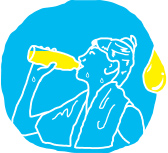
Drink frequently
Even if you are not thirsty, drink liquids frequently. Sports drinks and other beverages that contain salt or sugar can help you to absorb the moisture smoothly and help to replenish sodium lost from perspiration.
-

Get enough sodium
There is no need to eat a lot of salt, but make sure to get enough sodium in your daily meals. On days that you sweat a lot, be especially careful about getting enough sodium. However, if your physician has restricted your intake of liquids and sodium, please follow the doctor's instructions after consultation.
-
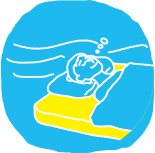
Maintain a comfortable sleeping environment
Prepare your sleeping environment using breathable bedding with good water absorbency and moderate use of air conditioning or electric fans, to prevent heatstroke while you are sleeping. Get a good sleep every night to prevent heatstroke the following day.
-

Build a strong body
Eat balanced meals, sleep well, and build a strong body. It is important to manage your physical condition to make your body resistant to heatstroke.
Strategy2
Design your daily life to deal with the heat.
Heat can be made tolerable with ingenuity and preparedness. Moderate air conditioning will keep the indoor temperature comfortable and creative thinking about what you wear will help you avoid the risk of heatstroke. Use sunshades to protect yourself from direct sunlight and make it a habit to constantly pay attention to the risks of heatstroke in the environment you are in.
-
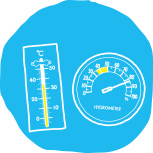
Always be aware of the temperature and humidity
Always care about the temperature and humidity of the environment you are in. When indoors, prevent the temperature and humidity from rising by blocking out direct sunlight and improving ventilation.
-
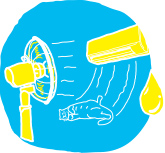
Keep it cool indoors
Cool down room temperature with an electric fan or air conditioner. Do not try to endure the heat for excessive power savings or thinking that you can handle it.
-

Be creative with what you wear
Control how hot you feel by wearing the right clothes. Choose fabric that breathes, like hemp or cotton. For underwear, choose a material that absorbs and dries quickly.
-

Avoid direct sunlight
Wear a hat or carry a parasol to protect yourself from direct sunlight. Walk and conduct activities in the shade when you can.
-

Keep cooling products on you
Use cooling products like cooling sheets and scarves, and ice pillows. All sorts of these products are available, from things for everyday use to goods that help you sleep on an uncomfortably hot summer night. Cool your body more efficiently by cooling where large blood vessels close to the surface are, such as the base of the neck.
 Heatstroke Facts
Heatstroke Facts
In addition to knowing the day's maximum temperature, you can prevent heatstroke more effectively by knowing how the temperature and humidity are expected to change, and being aware of indoor temperature and humidity.
Understanding your present environment is very important for preventing heatstroke. Your physical condition is a major factor in coming down with heatstroke. As you take note of your environment, know your body and be sensitive to its condition.
Strategy3
Take action to protect yourself from heat particularly when and where you most need it.
When participating in sports under the sun or working in an environment without air conditioning, you need to take action to protect yourself from the dangers of heatstroke. Be sure to get enough liquids and sodium, and take breaks frequently.
-
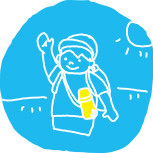
Take a drink with you
When you go out, always carry a drink bottle with you so that you can immediately rehydrate when you think of it.
-

Take regular breaks
When taking part in activities where you are exposed to heat or sunshine, take frequent breaks and remember to take it easy.
-
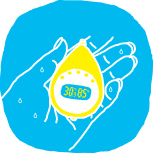
Pay attention to the heatstroke index
Be aware of the risk of heatstroke by keeping an eye on the heatstroke indexes shown on heatstroke index meters, television, or the internet.
 Heatstroke Memo
Heatstroke Memo
The Japan Weather Association has taken various initiatives to help prevent heatstroke, including issuing a heatstroke index, commentaries by weather forecasters, and developing heatstroke index meters, among others. Heatstroke can be prevented by paying attention. Do not make it about others. We can all help to reduce the number of cases of heatstroke to zero, to protect our own health and the health of our loved ones.

